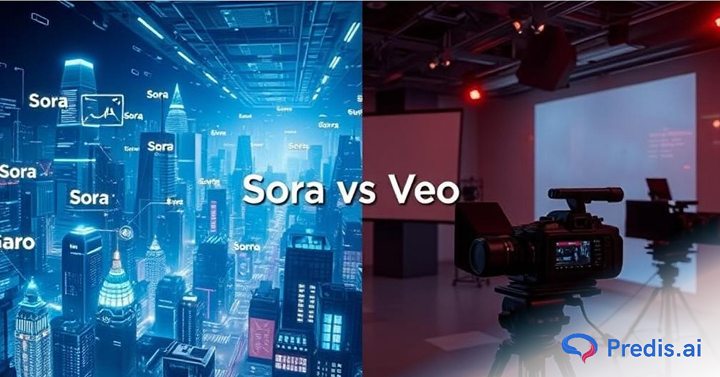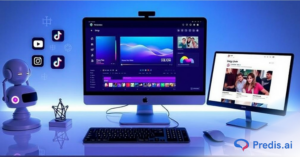The use of AI has revolutionized the content creation process. The first to appear were text-to-image applications such as DALL·E and Midjourney. Generating videos using AI is the next big thing. When discussing the leading contenders, the names Sora by OpenAI and Veo by Google DeepMind tend to be mentioned most frequently. They both claim they can turn basic text commands into amazing video clips. But they all have different capabilities, and knowing what makes each one unique can help you choose the best one for your needs or those of your business. We’ll evaluate Sora vs Veo side by side, looking closely at how well they work in the real world, how much they cost, and how good their audio and video quality is. You can use this knowledge to decide which one to focus on in 2025.
Quick Comparison: Sora vs Veo at a Glance
| Feature | Sora (OpenAI) | Veo (Google DeepMind) |
|---|---|---|
| Developer | OpenAI | Google DeepMind |
| Core Focus | Long-form, flexible AI-generated video | Cinematic, short, high-fidelity clips |
| Audio Support | Added in Sora 2 | Built-in native audio (music, speech, effects) |
| Typical Duration | Up to around 60 seconds | About 8–10 seconds |
| Resolution | 1080p (experimental 4K) | High-definition cinematic quality |
| Integration | ChatGPT, Sora app, OpenAI ecosystem | Gemini, Vertex AI, Google tools |
| Best For | Creators, marketers, educators | Filmmakers, studios, enterprises |
Both tools push boundaries, but each shines in different areas. Let’s break it down further.
1. Video Quality and Realism
Sora and Veo have both made video clarity a lot better.
- Sora is different because it can create longer sequences that make sense and have smooth transitions in motion. It uses a mix of transformer and diffusion designs, which helps it better comprehend how frames fit together. The results look and feel real, with the right lighting and adjustments in point of view.
- Veo, on the other hand, is all on making videos that look authentic. It often seems like what it sees comes from a movie camera. The lighting, shadows, and effects are all really well done. It also does a terrific job with physics, such how shadows move and how things interact with each other.
- When you need to write extensive stories or marketing content, Sora allows you more freedom. But if you care about great picture quality and cinematic art, Veo is the best.
2. Audio Generation and Synchronization
Audio is one of the most significant differentiators in the Sora vs Veo battle.
- When Sora first launched, it lacked audio output – users had to add sound in post-production. However, with Sora 2, OpenAI adds synchronized audio generation, which makes it more useful for artists. You can now generate short scenes with background sounds, lights, and spoken lines.
- But Veo has had audio built in since its first versions. It makes images and sounds that make videos feel more real and engaging. Turn on background noise, footsteps, soundscapes, and other environmental sounds automatically.
- Veo is the best at making video clips with speech or music that are ready to be published. Sora provides you more creative power if you wish to alter or remix your audio later.
3. Control, Prompting, and User Experience
AI-generated content needs to be prompted, and each model gives users a different experience.
- Sora allows creators to explain their work in simple terms, such as “A drone shot over snow-covered mountains at sunrise, with soft golden light reflecting off the peaks.” Sora makes a video about this on its own. You can prolong sequences or alter frames without starting again with prompt chaining.
- The ChatGPT and app interfaces for Sora are easy to use and understand.
- Veo, on the other hand, is aimed for developers, studios, and professionals that want to use Gemini and Vertex AI together. It’s easier to control the angles of the camera, the speed of the motion, and the transitions between scenes. It lets you input data in a systematic way so that frames are always the same.
Sora is easier to use. Veo wins in enhanced scene control and business processes.
4. Output Length and Resolution
- One of the best things about Sora is that it can make videos that are longer. Most AI models don’t let users construct sequences that continue more than 60 seconds. That’s ideal for videos that sell stuff, tell stories, or explain things.
- Veo, on the other hand, only shows clips that are 8 to 10 seconds long. But those few seconds are extraordinarily clear, with bright colors, motion like in a movie, and a depth of focus that appears real. It’s perfect for trailers, social media ads, and teasers that really grab people’s attention.
To sum up: Sora is a good choice if you need length and continuity. If you require short-form quality, pick Veo.
5. Pricing and Cost-Efficiency
Prices change all the time, but it’s easy to detect the trends.
- Sora is normally included in OpenAI’s ChatGPT Plus or Pro plans, thus no one knows how much it costs. People who make things in the ecosystem can afford it.
- Veo pricing for businesses is linked to Google’s Gemini and Vertex AI environments. Early users said that video prices were per second, especially for high-resolution audio clips.
- Freelancers and small enterprises could find Sora to be less expensive. Veo’s structured pricing may be worth the money for production companies and business users who want consistency and the capacity to grow.
6. Safety, Copyright, and Ethics
As more AI-generated content is made, problems with safety, ownership, and copyright become more common.
- OpenAI emphasizes responsible AI use. Sora stops content that is abusive or against the law. Watermarking and licensing make things more clear. Like any other AI system, this one has problems with training data and IP ownership.
- Google Veo uses a similar method. It limits generations that are focused on real people or specific themes, especially in business. Veo keeps track of AI-made videos with metadata.
- Before making commercial content, businesses and producers must check the usage rights for both platforms. Users need to be ethical, yet both companies are becoming more open.
7. Integration and Workflow
When you use an AI product every day, integration is usually what makes it feel smooth.
- Sora is a big part of the OpenAI ecosystem, and it works closely with ChatGPT in this space. Because you can create, write, and brainstorm all in one place, it is a great tool for coming up with ideas quickly.
- Veo fits very well with Google’s Gemini and Vertex AI systems. This integration will be very helpful for professional teams that use Google Cloud, Workspace, or editing suites like DaVinci Resolve or Premiere Pro.
In other words, Sora is for creators and marketers, while Veo is for corporations and those who work in cinema.
8. Real-World Performance and Use-Case Scoring
| Criteria | Sora | Veo |
|---|---|---|
| Video Length | ⭐⭐⭐⭐ | ⭐⭐⭐ |
| Visual Quality | ⭐⭐⭐⭐ | ⭐⭐⭐⭐⭐ |
| Audio | ⭐⭐⭐ | ⭐⭐⭐⭐⭐ |
| Ease of Use | ⭐⭐⭐⭐ | ⭐⭐⭐ |
| Cost Efficiency | ⭐⭐⭐⭐ | ⭐⭐⭐ |
| Enterprise Integration | ⭐⭐⭐ | ⭐⭐⭐⭐ |
| Safety & Policy | ⭐⭐⭐⭐ | ⭐⭐⭐⭐ |
Overall:
- Sora is the best in terms of speed, cost, and ease of use.
- Veo is the best when it comes to sound design, realism, and production quality.
Each model appeals to a distinct group of people, so the decision is less about which one is “better” and more about which one is “better for you.”
9. Sample Prompt and Expected Result
To see how these tools work in real life, picture giving both models the identical prompts:
- Prompt: “A movie chase scene through a city at night with neon lights, rain pouring down, and reflections on the wet pavement.”
- Veo: Makes stunning images with lighting that looks like it came from a movie and motion blur that looks real.
- Sora: Has a lengthier scene and tells a more dynamic story, but the details are a little less clear.

10. Workflow Tips to Maximize Results
If you’re just starting to make AI videos, these basic tips can help you get better results:
- Make specific prompts that include the type of camera, the mood, the lighting, and the movement.
- Start with shorter iterations and make previews before you commit to high-resolution outcomes.
- Add or improve the audio. Even if your model comes with audio, blending it in after the fact makes it sound better.
- Remember your aspect ratio: 16:9 for YouTube and 9:16 for TikTok and Reels.
- Follow the rules for rights and don’t use copyrighted characters or brand images.
- Stay up to date – these tools change quickly, with new features coming out virtually every month.

11. Beyond Sora and Veo: Other Notable Players
Sora and Veo are the most popular tools in 2025, however there are other tools that are also becoming popular.
- Runway Gen-2, Pika Labs, and Kling AI are all popular choices for creators who seek speedy results without paying a lot.
- Runway is a terrific tool for editing and telling stories. Pika lets you customize a lot, while Kling is quite realistic. By including these in your study, you can be sure to choose a tool that fits your needs and goals.
12. The Future of AI Video Generation
- Sora and Veo are both early signs of a much greater trend.
- In the next few years, you can expect longer times, higher resolutions, and real audio-visual coherence.
- Sora is anticipated to start making interactive stories, while Veo is likely to go deeper into making movies with full soundtrack synchronization. The rivalry between OpenAI and Google will only speed up new ideas, giving people greater power for less money.
Conclusion
Here’s what we found after looking into Sora and Veo from every angle: video quality, audio, price, control, safety, and integration. If you want lengthier films, a lower price, and something that’s easy to use, choose Sora. It’s great for teachers, marketers, and people who work alone. If you need realistic movies, built-in sound, and business tools, choose Veo. It’s great for studios and professional movie creators.
Both models are actually changing what is possible while making videos. One thing is for sure: AI video generation is the future of visual storytelling, whether you choose Sora’s creative freedom or Veo’s polished look.
















